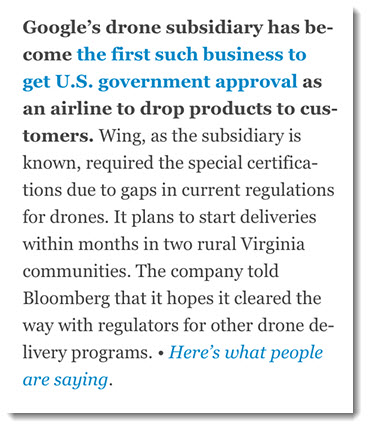Drawalong AR Turns YouTube Art Tutorials Into Augmented Tracing Paper — from vrscout.com by Kyle Melnick
5 Myths of AI — from thejournal.com by Dian Schaffhauser
Excerpt:
No, artificial intelligence can’t replace the human brain, and no, we’ll never really be able to make AI bias-free. Those are two of the 10 myths IT analyst and consulting firm Gartner tackled in its recent report, “Debunking Myths and Misconceptions About Artificial Intelligence.”
From LinkedIn.com today:

Also see:
From DSC:
I don’t like this at all. If this foot gets in the door, vendor after vendor will launch their own hordes of drones. In the future, where will we go if we want some piece and quiet? Will the air be filled with swarms of noisy drones? Will we be able to clearly see the sun? An exaggeration..? Maybe…maybe not.
But, now what? What recourse do citizens have? Readers of this blog know that I’m generally pro-technology. But the folks — especially the youth — working within the FAANG companies (and the like) need to do a far better job asking, “Just because we can do something, should we do it?”
As I’ve said before, we’ve turned over the keys to the $137,000 Maserati to drivers who are just getting out of driving school. Then we wonder….”How did we get to this place?”

We Built an ‘Unbelievable’ (but Legal) Facial Recognition Machine — from nytimes.com by Sahil Chinoy
“The future of human flourishing depends upon facial recognition technology being banned,” wrote Woodrow Hartzog, a professor of law and computer science at Northeastern, and Evan Selinger, a professor of philosophy at the Rochester Institute of Technology, last year. ‘Otherwise, people won’t know what it’s like to be in public without being automatically identified, profiled, and potentially exploited.’ Facial recognition is categorically different from other forms of surveillance, Mr. Hartzog said, and uniquely dangerous. Faces are hard to hide and can be observed from far away, unlike a fingerprint. Name and face databases of law-abiding citizens, like driver’s license records, already exist. And for the most part, facial recognition surveillance can be set up using cameras already on the streets.” — Sahil Chinoy; per a weekly e-newsletter from Sam DeBrule at Machine Learnings in Berkeley, CA
Excerpt:
Most people pass through some type of public space in their daily routine — sidewalks, roads, train stations. Thousands walk through Bryant Park every day. But we generally think that a detailed log of our location, and a list of the people we’re with, is private. Facial recognition, applied to the web of cameras that already exists in most cities, is a threat to that privacy.
To demonstrate how easy it is to track people without their knowledge, we collected public images of people who worked near Bryant Park (available on their employers’ websites, for the most part) and ran one day of footage through Amazon’s commercial facial recognition service. Our system detected 2,750 faces from a nine-hour period (not necessarily unique people, since a person could be captured in multiple frames). It returned several possible identifications, including one frame matched to a head shot of Richard Madonna, a professor at the SUNY College of Optometry, with an 89 percent similarity score. The total cost: about $60.
From DSC:
What do you think about this emerging technology and its potential impact on our society — and on other societies like China? Again I ask…what kind of future do we want?
As for me, my face is against the use of facial recognition technology in the United States — as I don’t trust where this could lead.
This wild, wild, west situation continues to develop. For example, note how AI and facial recognition get their foot in the door via techs installed years ago:
The cameras in Bryant Park were installed more than a decade ago so that people could see whether the lawn was open for sunbathing, for example, or check how busy the ice skating rink was in the winter. They are not intended to be a security device, according to the corporation that runs the park.
So Amazon’s use of facial recognition is but another foot in the door.
This needs to be stopped. Now.
Facial recognition technology is a menace disguised as a gift. It’s an irresistible tool for oppression that’s perfectly suited for governments to display unprecedented authoritarian control and an all-out privacy-eviscerating machine.
We should keep this Trojan horse outside of the city. (source)
DC: What kind of future do we want? #LawSchools #legislatures #society #EmergingTechnologies #citizens #governments #lawyers #legal #laws https://t.co/ICLkJY0yKP
— Daniel Christian (@dchristian5) April 19, 2019
Addendum on 4/20/19:
Amazon is now making its delivery drivers take selfies — from theverge.com by Shannon Liao
It will then use facial recognition to double-check
From DSC:
I don’t like this piece re: Amazon’s use of facial recognition at all. Some organization like Amazon asserts that they need facial recognition to deliver services to its customers, and then, the next thing we know, facial recognition gets its foot in the door…sneaks in the back way into society’s house. By then, it’s much harder to get rid of. We end up with what’s currently happening in China. I don’t want to pay for anything with my face. Ever. As Mark Zuckerberg has demonstrated time and again, I don’t trust humankind to handle this kind of power. Plus, the developing surveillance states by several governments is a chilling thing indeed. China is using it to identify/track Muslims.
Can you think of some “groups” that people might be in that could be banned from receiving goods and services? I can.
The appalling lack of privacy that’s going on in several societies throughout the globe has got to be stopped.
Blockchain could be used by at least 50% of all companies within 3 years, Oracle exec says — from forbes.com by Monica Melton with thanks to Michael Mathews for his LinkedIn-based posting on this
Excerpt:
Ten years after the idea of blockchain was conceived, the technology that underpins cryptocurrencies is starting to be used by large enterprises as a secure way to track goods. But mass utilization is still years away, and it won’t be for every company, said a panel of blockchain executives.
“My projection is that between 50% and 60% of companies will use blockchain in the next few years,” said Frank Xiong, Oracle’s group vice president of blockchain product development at the Forbes CIO Summit in Half Moon Bay, California, Monday.
Helvetica, the world’s most famous typeface, gets a makeover — from fastcompany.com by Mark Wilson
Helvetica is one of the most popular typefaces on the planet. Here’s why Monotype decided to remake it.
Excerpt:
Helvetica Now is the product of two dozen type designers, and when you see everything it can do, you’ll see why. First and foremost, Helvetica Now offers three separate “masters” (or three separate Helvetica variations) for various use cases. Its “Micro” version is for small screens. “Display” is for signage. And “Text” is for more standard sizes in written materials. Each of these options will cause the letters to be both drawn and spaced differently.
Also see:
Bauhaus architecture and design from A to Z — from dezeen.com by Tom Ravenscroft
Excerpt:
To conclude our Bauhaus 100 series, celebrating the centenary of the hugely influential design school, we round out everything you need to know about the Bauhaus, from A to Z.